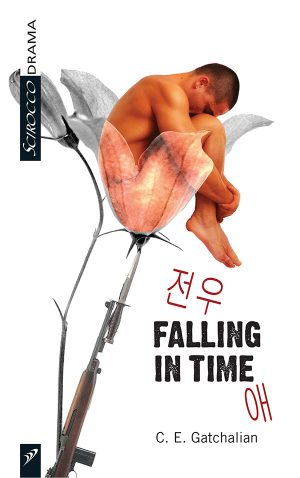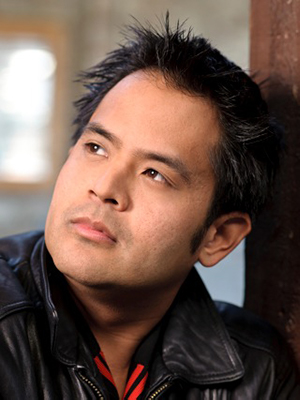Posted January 5, 2023
The Interview – C.E. (Chris) Gatchalian
C.E. Gatchalian
Born, raised and based on the unceded territories of the Coast Salish peoples, including the Musqueam, Squamish and Tseil-Waututh, C.E. Gatchalian is a queer Filipinx-Canadian author. The author of six books and co-editor of two anthologies, he is a three-time Lambda Literary Award finalist and the recipient of two Jessie Richardson Awards for his work as a theatre artist and producer. In 2013 he received the Dayne Ogilvie Prize in 2013, awarded annually by The Writers’ Trust of Canada to an outstanding emerging LGBTQI+ writer. Chris’s plays include Falling in Time, People Like Vince, Motifs and Repetitions, Claire, Broken, and Crossing. Formerly Artistic Producer of the frank theatre company, Vancouver’s professional queer theatre company, Gatchalian’s plays have been produced locally, nationally and internationally. His memoir is titled: Double Melancholy: Art, Beauty and the Making of a Brown Queer Man.
Chris, I know you’ve been working on a new version of your 2012 play Falling in Time. I’m particularly interested in what compelled you to, as you said, “crack open” Falling in Time, which is such a powerful play.
I’m very grateful for the opportunity to revisit this play–it’s a rare opportunity indeed! Essentially, since the play was produced and published a decade ago, it has never left my radar. I always felt there was more to do with it. The last three years–with all the conversations that have transpired around white supremacy, toxic masculinity, imperialism, colonialism–have only strengthened this feeling. I actually feel like this play is more relevant now that it was when it premiered over a decade ago, mostly because audiences actually have the vocabulary now to deal with the issues the play deals with, vocabulary they didn’t have back in 2012. So the new version hits harder, and doesn’t pull any punches. I’ve had the great honour and privilege of undertaking the journey of revisiting Falling in Time with my director and dramaturge Peter Hinton-Davis–from whom I have learned so much–as well as with my cultural consultants Diane Roberts and Maki Yi, and a crew of fantastic actors and other artists. We’re looking at a Toronto production of the new version within the next three years.
You’re currently an Equity, Diversity, and Inclusion scholar-in-residence at the University of British Columbia. What has that experience been like for you?
So far, wonderful. I’m associating with a diverse array of folx who genuinely care about dismantling old systems that have created harm and division, and creating new ones in which care and inclusion are core values. For me personally, it has been revelatory to lean into my indigenous, pre-colonial Filipino heritage–after a lifetime of being in the grip of colonialism and capitalism, and only recently realizing just how fully these forces have harmed me, it’s high time I undertake this journey home.
And now you have embarked on a new adventure, as Community Engagement Producer for CultureBrew.Art. Can you tell us more about the initiative and what it does?
CultureBrew.Art (CBA) is a digital platform that promotes and fosters interculturalism and equity throughout the performing, literary, and media arts. Its central tool is a national searchable database of Indigenous and racialized artists – actors, writers, singers, musicians, dancers, filmmakers, directors, designers, composers, choreographers, stage managers, and other arts and culture professionals – to which opportunity-makers and decision-makers like theatres, dance and opera companies, film/TV casting professionals, publishers, editors, indie directors/producers, schools, community and social service non-profits, government agencies, media outlets, ad agencies, and more may access as subscribers.
In addition to being seen by a growing group of subscribers, benefits for CBA artist members include access to good paying opportunities from across the country; the ability to directly connect with other BIPOC (Black, Indigenous, People of Colour) members through our secure internal messaging system; and the opportunity to be promoted on our social media channels and monthly newsletters. I also want to add that the privacy and security of our members are a huge priority for us, so we invest a significant amount of resources on regular security upgrades. For example, we will be adding multi-factor authentication early in 2023.
For members and non-members alike, I co-host the BIPOC Monthly Chat & Chew, a free monthly series of chats co-facilitated with CBA’s Co-Director, Anju Singh. Conducting the chats online means the series is accessible to BIPOC artists across Canada, and provides an opportunity for cross-country connection, as well as to talk, in a relaxed and safe space, about issues of concern for BIPOC arts practitioners.
Most recently, we had our official national launch event in November, which took place online and featured the fabulous actor and writer Jean Yoon (best known as Mrs. Kim in Kim’s Convenience) as our guest speaker (clips of the event will be posted on our social media channels this month). We currently have over 500 artists from coast to coast to coast in our system, and close to 400 published artist profiles.
One of the things I love about this job is that everyone on the CBA team is a BIPOC artist with lived experience of most things that being a BIPOC artist entails, including the systemic racism that, sadly, is still prevalent in the Canadian arts scene. It’s not a crew of faceless bureaucrats running CBA—we’re all practicing professional artists intent on helping level the playing field for BIPOC artists across the country, particularly CBA’s founder and Co-Director, Valerie Sing Turner, who is also the founding Co-Artistic Producer of the non-profit Visceral Visions, which created CultureBrew.Art.
Who should join CultureBrew.Art?
Any artist resident in Canada who works in the performing, media and literary arts AND who identifies as BIPOC (Black, Indigenous, People of Colour) can become an artist-member of CBA. (The visual arts is a realm that we are still researching and consulting on, so we’re not yet open to visual artists—but visual artists who also work in the performing, literary, or media arts are absolutely welcome to join now.) There is a nominal $25 annual membership fee; that said, we never want finances to be a barrier to joining CBA, so CBA offers bursaries upon request. And thanks to the wonderful generosity of our official launch guest artist, we have now established the Jean Yoon Bursary Fund!
As for artists who don’t identify as BIPOC but would like to support and work with BIPOC artists, they can subscribe to CBA for as little as $6/month. An engager subscription allows you to access the database, directly connect with artist-members, and submit an unlimited number of opportunity postings throughout an active subscription (e.g., calls for artists, job positions, professional development opportunities).
Whether you’re a BIPOC artist or an engager who wants to find and hire BIPOC artists, we invite you to join CBA. Contact me if you have any questions. If you’re a BIPOC artist, I have a promo code that will waive the $25 annual fee for your first year of membership — you can contact me for that as well!
Chris, you wrote a memoir, Double Melancholy: Art, Beauty, and the Making of a Brown Queer Man that was released in 2019 by Arsenal Pulp Press. It’s a beautiful book: a meditation on the power of art, an indictment of the racist and homophobia systems you’ve had to navigate, and an unflinchingly honest look back at various stages of your life, told in a unique multiple-voice narrative. Can you tell us why you wanted to share your personal story?
It started out as a collection of essays about the art works that have inspired me during the course of my life. When I first envisioned the book, I don’t think I set out to “indict” racism and homophobia per se. But I ended up doing so, as a logical consequence of my waking up, in the writing of the book, to how, as a racialized queer man, I have been marginalized and erased by Western media (and I’m using the term “media” here in the broadest sense possible, to include art–both high and low–literature, music, and television). As a cloistered, painfully shy, anxiety-ridden, neurodivergent kid raised by a single mom, the media was my world, my life. And to see virtually no representations of people who were similar to me or looked like me was, looking back, insidious and traumatizing. The art I loved simultaneously edified and erased me. I’m approaching 50, and I’m only now beginning to really, genuinely find a sense of self, because I had no Filipino queer men to look up to when I was younger. I think the significance of lacking this in my life can’t be overstated.
Writing Double Melancholy was probably the most draining experience I’ve had as a writer. It has also been one of the most rewarding because of the personal, political and spiritual growth it has triggered. My journey to self-realization–far from complete!–didn’t end with the book’s publication. On the contrary, it was the beginning of it.
In the book, you talk about how A Streetcar Named Desire changed your life. Tell us a bit about that!
I first saw Streetcar when I was thirteen years old. This was long before I came out, but I already intuited that my erotic desires leaned in a different direction from the majority of folx, and Streetcar, which to a large degree is a story of unconventional sexual desire, spoke to me in a primal, visceral way. It gave words and images to things that were part of my inner life but that, at thirteen, I didn’t yet have the vocabulary for. The play’s sexuality, and its poetry–its impact on me was overwhelming. I realize and accept that on a number of fronts–race, gender, sexuality–Tennessee Williams and his work, viewed through a contemporary lens, is problematic. And he was a brilliant artist whose work continues to inspire. I think we can embrace complexity and hold space for conflicting feelings.
Who are the writers who inspire you today?
So many. I’ll furnish a list, but with the caveat that there are others who inspire me just as much who are simply not in my brain-space at the time of this writing! So, in no particular order: Leny Mendoza Strobel, Susanne Langer, Adrienne Dengerink Chaplin, Samuel Beckett, Jose Rizal, Sarah Schulman, James Baldwin, Donna-Michelle St Bernard, Billy-Ray Belcourt.
Are there any other upcoming projects or events that you’d like to tell us about?
With Teodoro ‘Ted’ Alcuitas and Patria Rivera, I’m co-editing Magdaragat, An Anthology of Filipino-Canadian Writing. It’s the first anthology of Filipino-Canadian writing to be published by a mainstream publisher–it’s due out later this year from Cormorant Books. I’m also writing my first novel, on which I’m making slow but steady progress. Finally, in early spring, for those in Vancouver, I’ll be facilitating the fifth instalment of QueerAsian, a writing series for writers of Asian descent who identify as 2SLGBTQI+
-
 Falling in Time$9.99 – $14.95
Falling in Time$9.99 – $14.95

